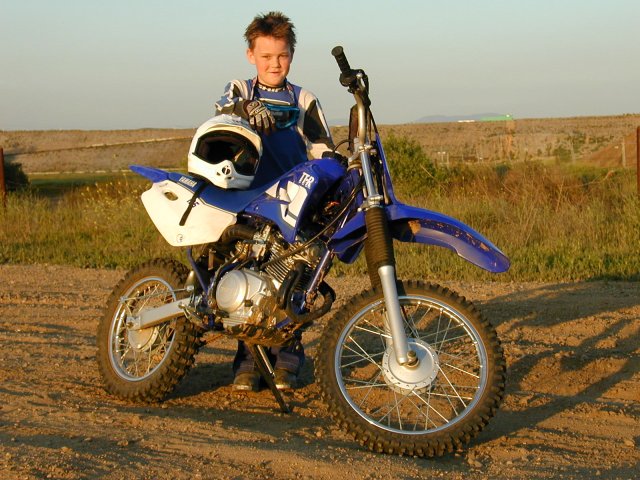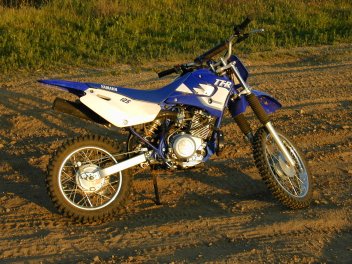
For years, major manufacturers have largely ignored the entry-level rider, and the shorter trail rider — be they men or women. Sure, there are products for these riders, but they tend to be old and outdated. The big bucks are spent on developing cutting-edge machines for experienced and skilled riders — with long inseams.
With motorcycling growing at an unprecedented rate, however, there is just no excuse for a lack of investment in machinery for those markets. The number of new riders, both young and old, as well as the number of shorter riders, is increasing every year.
To its credit, Yamaha has brought more than one new product out this year for riders in these categories. We were anxious to try the TT-R125, because its light weight and user-friendly, four-stroke power delivery made us think it would be fun, and powerful enough to be a functional trail machine for small or less aggressive trail riders. With a seat height of just 30.1 inches, and a low center of gravity, sitting on the TT-R125 inspires confidence. It feels well balanced, and was comfortable for our 4’6″ test rider, Evan Edge, as will as his 5’3″ mother, Kim.

The TT-R125 has a bigger brother, with bigger wheels and a front disc brake, known as the TT-R125L. The “L” model has a 1.2 inch taller seat height, and would accommodate slightly taller riders better than the bike we tested.
Like most four-strokes these days, the TT-R125 comes with a stock exhaust system that is very restrictive. It makes the bike very quiet, but reduces its power output considerably. Nevertheless, with the stock pipe installed, the TT-R125 impressed Evan, who rode the bike extensively.
Evan has been riding since the age of three (he is now ten). He is not a racer, but he is a skilled rider for his age, and enjoys all types of trail riding, as well as casual riding on motocross tracks. His normal ride is a Suzuki DS80 — a two-stroke with pretty decent power output for a smaller trail rider, but a bike that is shorter than the TT-R125, and has less sophisticated suspension with shorter travel.
It took Evan a little while to get used to the TT-R125 (the first four-stroke he has ridden), but before too long he was having a blast on it. He loved the four-stroke power delivery, and the more compliant suspension. The four-stroke power allowed him to slide the rear wheel in turns more controllably (something he really loves doing), and the torque of the 124cc motor pulled him up all of his favorite hills with no problems.

He did find the front drum brake too weak for riding his favorite motocross track, but if adjusted properly the front brake is adequate for trail riding by lighter riders. As we stated earlier, by opting for the “L” model, you would enjoy the benefits of a front disc brake and much improved stopping power.
Both Evan and Kim found the suspension plush, and the handling of the bike predictable. This bike is not made to handle like an 80cc motocross bike — its steering geometry is more conservative. This provides added stability, but Evan nevertheless enjoyed the bike, particularly through wider sweeping turns.
With a 17 inch front tire and a 14 inch rear tire (the “L” model has taller tires, 19 inch front and 16 inch rear), there is a reasonably good selection of tires available, and the model we tested came with excellent stock rubber. The styling of the TT-R125 is far more modern than other bikes in this class, particularly, compared to Honda’s XR100. The motor performance is also tops in the class, and could be improved considerably through the use of an after market exhaust and jetting changes. As is, this is already a fun bike and a bulls eye by Yamaha for the intended market. It is a great bike to start on, with enough performance to be a fun trail ride for the moderately experienced rider.
The chassis and suspension is also a great starting point for a modified bike. The chassis stiffness is there, and the stock 124cc displacement means the potential performance is there as well. I’ve had at least two experienced (and fast) riders tell me about their desire to buy the “L” model and “trick it out”. I’ve had the same thoughts myself.
What’s the bottom line with this bike? If you have an entry-level rider who wants to learn how to shift (a number of entry level bikes have automatic clutches, but the TT-R125 has a real transmission and clutch with five speeds), I can’t currently think of a better bike than the TT-R125, or the TT-R125L. If you are a shorter rider, or have a shorter rider in the family, either of these bikes would make a fun trail bike.
If you are an experienced off road rider, and you’ve dreamt of a highly modified XR100, start thinking about a modified TT-R125L.
Yamaha’s MSRP for the 2000 TT-R125 is $2,299, while the “L” model retails at $2,499.00





